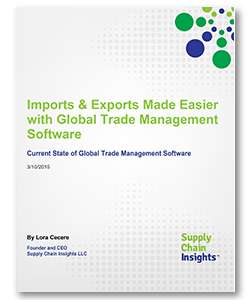Of White Picket Fences, Middle Class and Supply Chain Management

Today, fewer families are seeing the white picket fence - it's harder for our youth to find good jobs and we have a jobless recovery with the aging workforce and rising costs for social security, this is a major economic issue.
The middle class is synonymous with the dream of a home with a white picket fence.
In the last recession, the middle class was decimated in the United States: mainly replaced by low-wage jobs. Mid-wage occupations pay between $13.83 and $21.13 per hour.
They were 60% of the job losses in the last recession, but only represented 27% of the post recovery jobs.
So, today, fewer families are seeing the white picket fence. It is harder for our youth to find good jobs. We have a jobless recovery. With the aging workforce and rising costs for social security, this is a major economic issue.
Historically, most of the middle class jobs came from manufacturing. Today’s opportunity is for the jobs to come from supply chain management. However, training and reskilling will not happen overnight. While politician, after politician, argue about offshoring, reshoring and the impact of unionization, few are seeing the opportunities for growth of the middle class from building supply chain talent.It is time to stop fighting and get to work. The opportunity is large. The 2012, the Georgia Innovation organization reports that the United States will be short one million workers in Supply Chain by 2016.
Why Supply Chain Offers Opportunity for the Middle Class
Jobs are tightly linked with value creation. Making and growing things creates value. However, today, manufacturing and agriculture are highly automated with even more automation looming in the future. We are in a time of transition from regional manufacturing centers to creating global value networks where customer service, transportation, sourcing and manufacturing are tightly connected and cross borders.
Unlike finance where processes focus on money passing from hand-to- hand until there is nothing left; the processes of supply chain management are about creating value at each node, or link, in the chain. The links in the chain span countries and trading partners and define new business models. .
Why are the positions open? Supply chain jobs are new, academic programs are evolving and many don’t see them as sexy. Our fathers and mothers were not supply chain workers, and there are no clear and well-understood career paths. There are also few multi-cultural role models; as historically, it has been a closed world of older white men. Not so in the future…
It is a Global Opportunity
The lack of a middle class drives political unrest. Cultures of haves and have nots give rise to dictators, corruption, and terror. When I look into the eyes of a student in Spain from Chad and tell him that one in fifteen supply chain planning roles around the world are vacant waiting for him, he stares back in disbelief. For countries that have high levels of unemployment the thought of jobs with more demand and supply seems unfathomable; but, this is the case…. He needs a job. A co-op position or an internship for this student would open up a new world; yet, most of the hiring focus for supply chain leaders is in US schools where bachelor’s and master’s degree students are highly courted.
Ironically, the deepest supply chain curriculums in academia are in the United States and Europe, but the greatest needs are in Africa, Brazil, China, and India. This is a barrier for the growth of the global mutli-national company. As more and more baby-boomers retire, this will become more acute. Companies need to invest in their own talent development systems.
Figure 1: Global Unemployment Courtesy of the CIA

Where to Start:
The jobs are many, but for simplicity, let’s examine three immediate opportunities in the United States.
- Truck Drivers: Today, there are 30-35,000 unfilled truck driver positions in the United States. Globally, it is not much better. Older drivers are retiring, and the turnover is high. The average annual pay for a truck driver in the United States was $50,000 last year up from $39,000 from 2000. It is estimated that there is a shortfall of 115,000 jobs in the trucking industry today.
- Supply Chain Planners. One out of fifteen supply chain planning jobs are vacant today. With recent retirements, there is a mid-management talent shortage. The job combines knowledge of the supply chain with analytics and requires great communication skills. The positions pay $70,000-$100,000.
- Warehouse and Dock Workers. With the advancements in ecommerce, cold chain, serialization and last mile delivery, the skills for the warehouse worker are much higher today than five years ago. By 2020, the demand for dock workers will increase 22%. Today, the vocational schools are producing about 75,280 formally trained workers a year. The unfulfilled job gap is about 125,000 workers a year. The salary range is $40,000-72,000/year. The good news is that there are now associate degrees in supply chain in approximately fifty colleges in the United States. The bad news is that they are not graduating candidates quickly enough.
Now let’s shift focus and talk about the broader global issue. Globally, it is estimated that 42 million people are unemployed and 23 million people have dropped out of the job market due to discouragement and long-term unemployment. By 2016, it is estimated that there is a global need for 5 million supply chain workers (1 million in the United States). It is both a risk and an opportunity. It is a great opportunity to build a middle class economy, but it is a risk to global multi-national productivity if this does not happen quickly.
I was a child of the 60s. While my mother would not let me go to Woodstock, I did wear bell bottom jeans and flowers in my hair. I would chant, “Give peace a chance.” Today, I believe that supply chain matters more than ever. I think that great supply chain practices are key to saving the planet, instrumental to rebuilding the middle class, and essential for corporate performance. I think supply chain can save the world. How about you?
Sources:
- Washington Post, How the Recession turned Middle-class Jobs into Low-Wage Jobs, February 28,2013
- Global Employment Trends 2014, Risk of a Jobless Recovery?, International Labour Office, Geneva
- CNBC, Keep on Truckin’?, August 20, 2014

About the Author
Lora Cecere is the Founder and CEO of Supply Chain Insights, the research firm that’s paving new directions in building thought-leading supply chain research. She is also the author of the enterprise software blog Supply Chain Shaman. The blog focuses on the use of enterprise applications to drive supply chain excellence. Her book, Bricks Matter, was published in December of 2012.
Supply Chain Metrics that Matter new book
Supply Chain Management (SCM) - the combined processes of procurement (source), manufacturing (make) and logistics (deliver) - is now thirty years old. Empirically companies know that supply chain performance matters to corporate performance; however, groups argue on which metrics matter the most and why. This book answers these questions. Order Online
Related: Supply Chain Talent Is a Growing Gap for Leaders and the Impact Is Enormous

Article Topics
Supply Chain Insights News & Resources
Talking Supply Chain Podcast: Insights on Leaders - The Top 25 CHAPTER 3: Bricks Matter Infor Aquires GT Nexus - If I Had a Magic Wand! Why Are We Letting Digital Marketers Define The Future World View of The Supply Chain? Imports & Exports Made Easier with Global Trade Management Software Maximizing the ROI in Supply Chain Planning Getting Inventory Right: Hope with Hype and Recycled Supply Chain Software? More Supply Chain InsightsLatest in Supply Chain
Indiana Tests Futuristic Highway that Can Charge EVs While Driving Nike Signs 20-Year Lease on New UK Supply Chain Hub The Impact of Amazon Business Prime on Procurement Efficiency Week in Review: Baltimore Bridge Price Tag, FTC Fines Williams-Sonoma, and More Maersk Opens New 90,000-Square-Foot Airfreight Gateway in Miami GXO and Conair Open Maryland’s Largest Distribution Center Shipping Dispute Heats Up: Peloton vs. Flexport More Supply Chain













